Intel's Pentium M on the Desktop - A Viable Alternative?
by Anand Lal Shimpi on February 7, 2005 4:00 PM EST- Posted in
- CPUs
Overclocking to Save the Day?
Of course, the big question is - "What if you overclock it?"As you can expect, the Pentium M benefits greatly from being overclocked; not necessarily from the CPU being overclocked, but from the memory bus being overclocked. Unfortunately, as we mentioned before, the 855GME chipset and the two motherboards that we have based on it don't seem to want to overclock the memory bus too much, so we're left with somewhat nice performance gains from overclocking, but not ideal.
The problem with overclocking just the Pentium M is that it paints a skewed picture of reality - as comparing one overclocked processor to a ton of stock-clocked CPUs isn't really fair. But folks are always interested to see what an overclocked Pentium M can do, so we're here to show it off.
The beauty of the current Dothan based Pentium M CPUs is that they are 90nm chips, but without the heat issues of the Prescott based Pentium 4, meaning that they should overclock reasonably well. And overclock they do - our 2.0GHz sample easily hit 2.40GHz (133MHz x 18), and our 1.7GHz samples had no troubles getting up to 2.0GHz (one even hit 2.26GHz). We'd see bigger performance gains if we could bump up the memory clock beyond the 355MHz (to which we were limited), but that will most likely have to wait for new motherboards/chipsets.
Here are some abridged performance results with the overclocked Pentium M included:
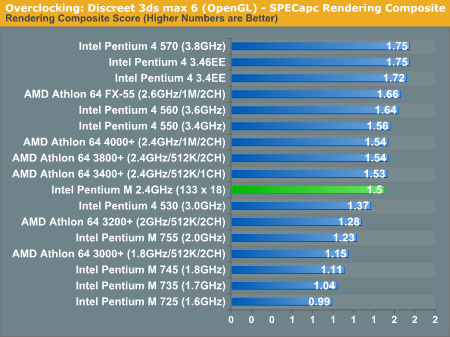

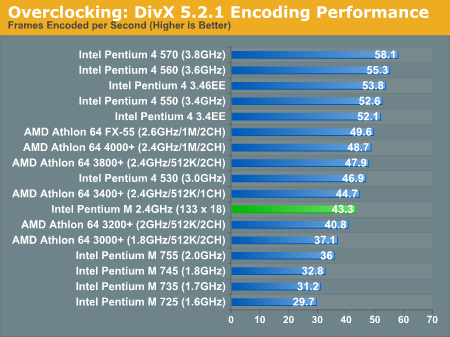
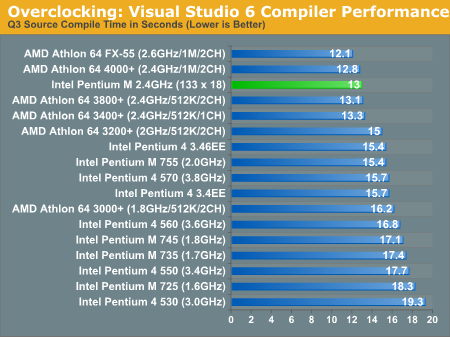
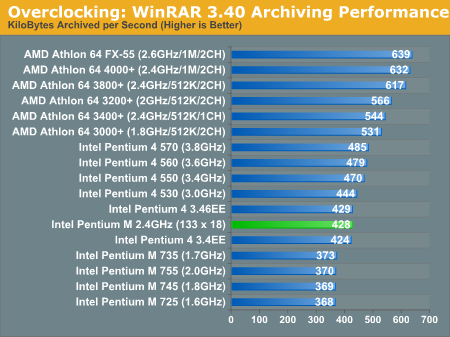
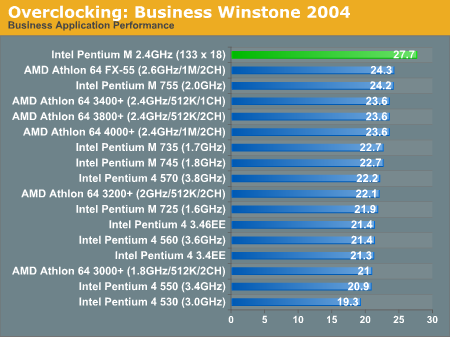
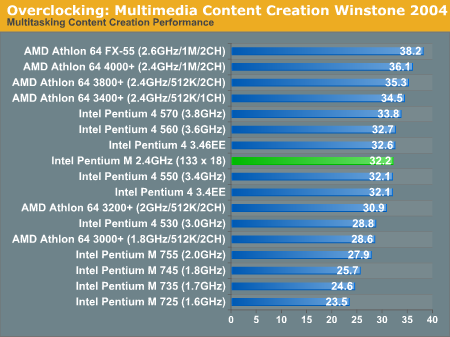
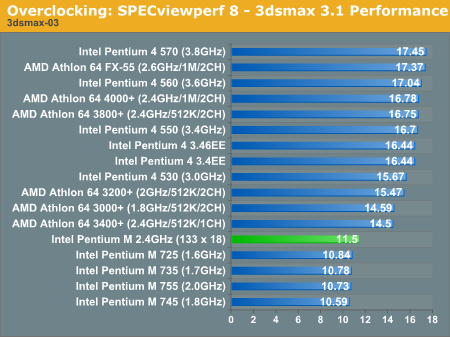
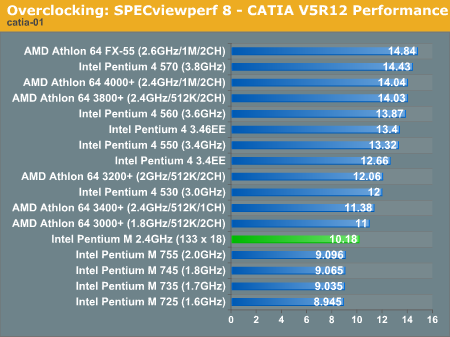

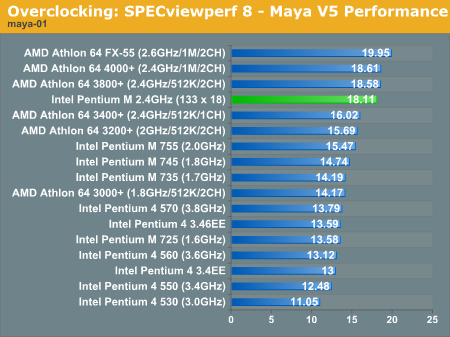
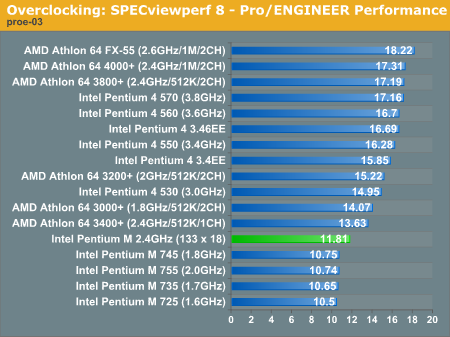
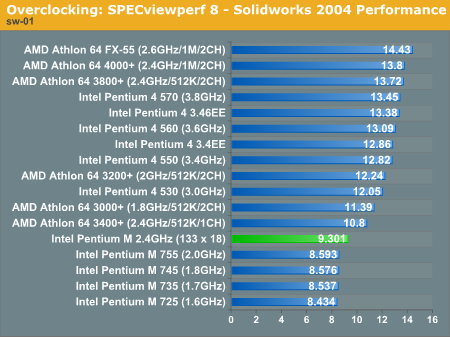
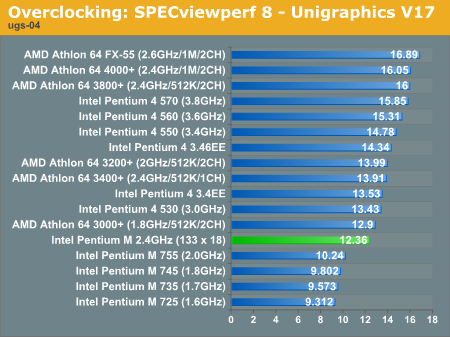










77 Comments
View All Comments
fitten - Tuesday, February 8, 2005 - link
Also, it's interesting that there are many benchmarks chosen which are known to stress the weaknesses of the Pentium-M... not that it isn't interesting information. For example, there seems to be a whole lot of FPU intensive benchmarks (around 15 or so, all of which the Pentium-M should lose handily - known before they are even run) so kind of just hammering the point home I guess.Anyway, the Dothans held up pretty well from what I can see... Most of the time (except for the notable FPU intensive and memory bandwidth intensive benchmarks), the Dothan compares quite well with Athlon64s of the same clock speed that have the advantage of dual channel memory.
fitten - Tuesday, February 8, 2005 - link
The other interesting thing about the Athlon64 vs. Dothan comparison is that even with dual channel memory bandwidth on the Athlon64's side, the single channel memory bandwidth of the Dothan still keeps it very close in many of the benchmarks and can even beat the dual channel Athlon64s at 400MHz higher clock in some.Anyway, the Pentium-M family is a good start. Some tweaking here and there (improved FPU with better FPU performance and maybe another FPU execution unit, improved memory subsystem to make good use of dual channel) and it will be at least as good as the Athlon64s across the board.
I own three Athlon64 desktops, two AthlonXP desktops, and two Pentium-M laptops and the laptops are by no means "slow" at doing work.
KristopherKubicki - Tuesday, February 8, 2005 - link
teutonicknight: We purposely don't change our test platform too often. Even though we are using a slightly older version of Premiere, it is the same version we have used in our other processor analyses.Hope that helps,
Kristopher
kmmatney - Tuesday, February 8, 2005 - link
There's also a Celeron version that would have been intersting to review. The small L2 cache should hurt the performance, though. I think the celeron version using something like 7 Watts. It would make no sense to put a celeron-M in such an expensive motherboard, though.Slaimus - Tuesday, February 8, 2005 - link
I think this indirectly shows how AMD needs to update its caching architecture on the K8. They basically carried over the K7 caches, which is just too slow when paired with its memory controller. Instead of being as large as possible (as evidenced by the exclusive caches) at the expense of latency, the K8 needs faster caches. The memory bandwith of L2 vs system memory is only about 2 to 1 on the K8, which is to say the L2 cache is not helping the system memory much.sandorski - Monday, February 7, 2005 - link
I think the Pentium M mythos can now be laid to rest.mjz5 - Monday, February 7, 2005 - link
to #29:your 2800 is the 754 pin.
the 3000+ reviewed is the 939 pin which is 1.8. the 3000+ for the 754 is 2.0 ghz
kristof007 - Monday, February 7, 2005 - link
I don't know if anyone else noticed but the charts are a bit off. My A64 2800+ is running at a stock 1.8 ghz .. while in the review the A64 3000+ is running at 1.8 ... weird!knitecrow - Monday, February 7, 2005 - link
#251) Intel and AMD measure TDP differently... and TDP is not the same as actual power dissipation. The actual dissipation of 90nm A64 is pretty darn good.
2) A microprocessor is not made of Lego... you can't rearrange/tweak parts to make it faster. It takes a lot of time, energy and talent to make changes -- even then it may not work for the best. Prescott anyone?
Frankly I’ve been waiting for a good review of P-M's actual performance. I really don't trust those "other" sites.
k00kie - Monday, February 7, 2005 - link